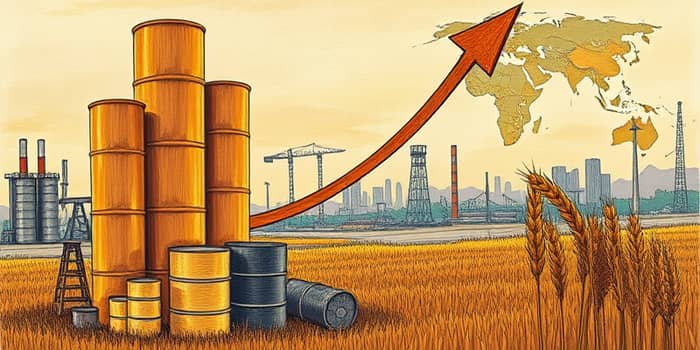
In an era of heightened economic uncertainty, the interplay between commodity prices and inflation expectations has drawn renewed attention from investors, policymakers, and households alike. As global demand patterns shift and supply constraints emerge, understanding the dynamics of commodity supercycles is crucial for anticipating future inflationary pressures and shaping effective policy responses.
This article explores the origins and mechanisms of commodity supercycles, reviews key historical episodes, analyzes current trends, and offers insights into the implications for various stakeholders navigating an evolving inflation landscape.
A commodity supercycle is a sustained phase—often lasting a decade or more—during which prices for a broad range of primary goods remain significantly above their long-term averages. These phases are not driven by fleeting market jitters but by structural shifts in global demand and supply, such as rapid industrialization, urbanization, or prolonged underinvestment in production capacity.
Key commodity groups involved include energy sources (oil, natural gas), base and precious metals (copper, aluminum, gold), and agricultural staples (wheat, corn, soybeans). The hallmark sequence consists of a sudden demand shock, a delayed supply response and oversupply, an investment surge, and eventual price correction, often accompanied by volatile boom-and-bust cycles.
Since the turn of the 20th century, four major bull supercycles have reshaped global inflation trajectories:
During the 2000s supercycle, global headline inflation climbed in tandem with commodity indices, compelling central banks to adjust policy frameworks. The U.S. core inflation rate peaked at 6.62% in June 2022 amid post-pandemic commodity spikes before retreating to 4.02% by October 2023 as supply chains stabilized and monetary tightening took hold.
Commodity price surges transmit to consumer prices through multiple pathways. At the producer level, raw input cost increases feed into intermediate goods, which in turn elevate retail prices. This sustained increases transmit directly to headline inflation, straining household budgets and corporate margins.
Financial markets and economic agents adjust their outlooks when they perceive a supercycle in motion. Wage negotiators may demand higher pay, and investors may require greater yields on bonds to compensate for eroding purchasing power. Central banks face the challenge of distinguishing transient from structural inflation, influencing the timing and magnitude of interest rate responses.
These feedback loops can become self-reinforcing, especially when price contracts in energy and agricultural sectors include multi-year lags. As a result, temporary shocks risk re-anchoring long-term inflation norms if policymakers do not act decisively.
Three primary forces underlie commodity supercycles:
Going forward, the global push for decarbonization and the global decarbonization and green transition is creating fresh demand for critical minerals like lithium, nickel, and cobalt. At the same time, regulatory measures—carbon taxes set to reach $170 per ton by 2030—may elevate energy costs, adding complexity to the outlook for future inflation.
Analysts are divided on whether the post-pandemic price surge heralds a full-fledged new supercycle. Proponents point to chronic underinvestment in traditional energy and metals alongside soaring demand for clean energy inputs. Skeptics argue that improved supply chain resilience and waning recovery-driven demand will keep inflationary pressures tame in the medium term.
Even if commodity prices moderate, the mere expectation of renewed supercycle conditions can prompt precautionary behavior among firms and consumers, sustaining higher inflation expectations and complicating central bank mandates focused on price stability.
Different actors face distinct challenges and strategies in the shadow of commodity supercycles:
Policy measures can mitigate—but rarely eliminate—the inflationary impact of supercycles. Fiscal tools like targeted subsidies or temporary tax rebates can provide relief at the household level, while regulatory reforms that streamline supply chain bottlenecks may alleviate structural constraints.
On the monetary side, central banks are refining frameworks to incorporate commodity indicators into inflation forecasts, aiming for preemptive action rather than reactive tightening.
Looking ahead, a deeper integration of climate policy with macroeconomic strategy will be essential. Coordinated global efforts to invest in both traditional and clean energy infrastructure can smooth the transition and reduce the amplitude of future commodity swings.
Commodity supercycles are powerful forces that reshape inflation expectations, influence policy trajectories, and impact financial markets. By understanding their historical patterns, transmission mechanisms, and evolving drivers, stakeholders can better navigate the risks and opportunities that lie ahead.
Whether the world stands at the dawn of a new commodity supercycle or faces a series of episodic price shocks, the imperative is clear: proactive analysis, robust policy frameworks, and strategic flexibility are vital to maintaining price stability and fostering sustainable economic growth.
References













